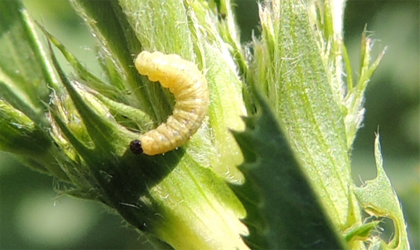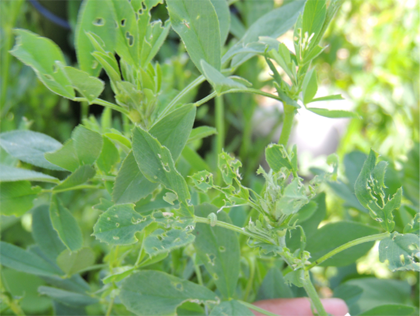By Anitha Chirumamilla and Dave Ollila
Record-high populations of alfalfa weevils are present this year. Monitoring for alfalfa weevils has been conducted since the last week of April and it wasn't until the last week of May that significant numbers were observed.
 Alfalfa weevil larva. Photo by: Anitha Chirumamilla, SDSU |
It appears that the weevil activity lagged approximately 3 weeks behind average degree day requirements. Almost each and every field in Fall River and Butte counties have weevil numbers beyond economic thresholds and the damage is significant.
The sampling populations are dominated with young weevil larvae ranging from first to third instars. Instars refer to the developmental stages of larva between two successive molts. Larvae at this stage of development have the capacity to cause severe defoliation as they have to go through four stages of development before pupation. Larval development completes in about 3 weeks from hatching to cocoon formation.
With such high populations of early larval instars, fields can turn white from weevil defoliation of the leaves in matter of days. Early harvest or applications of insecticides are the two recommended management strategies in the current situation.
Early Harvest
 Alfalfa weevil feeding damage. Photo by: Anitha Chirumamilla, SDSU |
Considering the height and growth stage of alfalfa, early harvesting is definitely a low-cost-effort and the least toxic method of reducing the defoliation by weevil larvae. However, the cool and wet conditions in South Dakota are making this difficult. Larvae and adults have a better chance of hiding under the windrows and delayed baling due to climate might put the regrowth at higher risk.
Moreover, adults are actively mating in the fields. Continued egg deposition by weevils in harvested stubble and feeding of the newly hatched larvae will severely affect alfalfa regrowth. Adult weevils feeding on the stubble might predispose the plants to diseases and in the case of dryland alfalfa, delayed regrowth might make the plants go dormant.
Chemical Application
The number of weevil larvae in alfalfa fields of South Dakota is beyond economic threshold (>75 larvae/30stems at 16 inches height), justifying the use of insecticides as a control option. If applied at this level of infestation, insecticides will prevent further damage and will extend the harvesting period window.
However, when choosing an insecticide, caution should be exercised in observing the pre-harvest intervals. In case of blooming alfalfa, select insecticides that are the least toxic to bees and choose the time of application when they are the least active. For information on decision making if insecticide treatment is necessary, the list of products recommended for alfalfa weevils is available as the Bugwood Wiki website.
More Information
South Dakota alfalfa growers need to take immediate action to reduce any further losses. For additional support in determining the best course of action, contact SDSU Entomologists, Ada Szczepaniec (Brookings, 605.688.6854) or Anitha Chirumamilla (Rapid City, 605.394.1722).
Considering the record level of infestation this year, alfalfa regrowth should be carefully monitored for weevil activity irrespective of the options chosen for first cutting (early harvesting or insecticide application).
For information on growing-degree day requirements, scouting techniques, and economic thresholds for alfalfa weevils refer to the iGrow article: Spring is Here: Watch out for alfalfa weevils






Post a comment
Report Abusive Comment